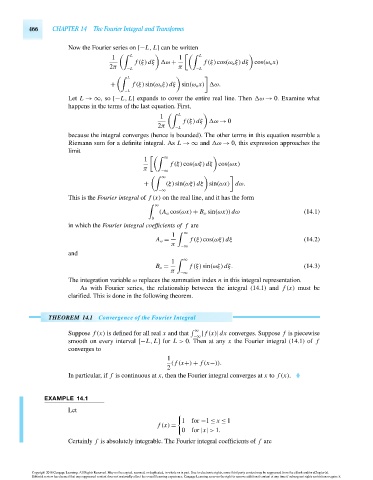Page 486 - Advanced engineering mathematics
P. 486
466 CHAPTER 14 The Fourier Integral and Transforms
Now the Fourier series on [−L, L] can be written
1 L 1 L
f (ξ)dξ ω + f (ξ)cos(ω n ξ)dξ cos(ω n x)
2π −L π −L
L
+ f (ξ)sin(ω n ξ)dξ sin(ω n x) ω.
−L
Let L →∞,so [−L, L] expands to cover the entire real line. Then ω → 0. Examine what
happens in the terms of the last equation. First,
1 L
f (ξ)dξ ω → 0
2π −L
because the integral converges (hence is bounded). The other terms in this equation resemble a
Riemann sum for a definite integral. As L →∞ and ω → 0, this expression approaches the
limit
1 ∞
f (ξ)cos(ωξ)dξ cos(ωx)
π
−∞
∞
+ (ξ)sin(ωξ)dξ sin(ωx) dω.
−∞
This is the Fourier integral of f (x) on the real line, and it has the form
∞
(A ω cos(ωx) + B ω sin(ωx))dω (14.1)
0
in which the Fourier integral coefficients of f are
1 ∞
A ω = f (ξ)cos(ωξ)dξ (14.2)
π −∞
and
1 ∞
B ω = f (ξ)sin(ωξ)dξ. (14.3)
π
−∞
The integration variable ω replaces the summation index n in this integral representation.
As with Fourier series, the relationship between the integral (14.1) and f (x) must be
clarified. This is done in the following theorem.
THEOREM 14.1 Convergence of the Fourier Integral
∞
Suppose f (x) is defined for all real x and that | f (x)|dx converges. Suppose f is piecewise
−∞
smooth on every interval [−L, L] for L > 0. Then at any x the Fourier integral (14.1) of f
converges to
1
( f (x+) + f (x−)).
2
In particular, if f is continuous at x, then the Fourier integral converges at x to f (x).
EXAMPLE 14.1
Let
1for −1 ≤ x ≤ 1
f (x) =
0for |x| > 1.
Certainly f is absolutely integrable. The Fourier integral coefficients of f are
Copyright 2010 Cengage Learning. All Rights Reserved. May not be copied, scanned, or duplicated, in whole or in part. Due to electronic rights, some third party content may be suppressed from the eBook and/or eChapter(s).
Editorial review has deemed that any suppressed content does not materially affect the overall learning experience. Cengage Learning reserves the right to remove additional content at any time if subsequent rights restrictions require it.
October 14, 2010 16:43 THM/NEIL Page-466 27410_14_ch14_p465-504

